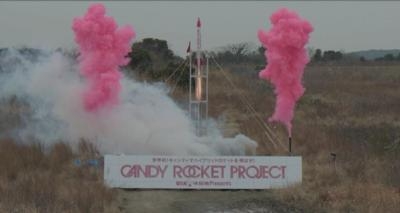Candies Served As Combustor To Launch Rocket To Over 800 Feet In Altitude
On March 7, the Candy Rocket Project Committee, organized by Japanese confectionery maker UHA Mikakuto Co. and aerospace experts, successfully launched a hybrid rocket using candies for fuel for the first time in the world. The launch was successfully conducted twice. The highest altitude reached was 813 feet.

Experts involved are Director Yutaka Wada of the Akita Space Development Institute at Akita University, Director Hiroaki Akiyama of the Institute for Education on Space at Wakayama University, and Professor Seiichi Sakamoto of the NAOJ Chile Observatory, all internationally renowned in space research and rocket development.
Hybrid rockets are researched as next-generation space transport rockets. However, the technology to launch a hybrid rocket using candies as solid fuel did not exist as of March 9, 2015. This launch was the world's first challenge at doing so.
Currently, a special movie on this project, including the launch of the Candy Rocket is available on the "Candy Rocket Project" website.
"We were relieved that the rocket was launched wonderfully," said Yutaka Wada, Director, Akita Space Development Institute, Akita University. "This project proved that candies can be used as a high energy fuel. If humans went to outer space and had to find energy from limited resources, candies that they brought for survival food could be used as emergency fuel when they ultimately have to escape. This research proved the capability of candies in such situation."
"One of the purposes of having adults like us create a challenge with free thinking was to have not only elementary and junior high school students, but also high school and university students notice that 'you can think more freely in the world,' and have them challenge various things," said Hiroaki Akiyama, Director, Institute for Education on Space, Wakayama University. "At the same time, we want to have them understand that it is important to gain an understanding of the people around them and create a supportive environment since 'free thinking' could cause worries and troubles."
"We were able to show another aspect of candies by showing how Puccho transforms from something enjoyable to eat to something that leads to children's dreams," said Yasumasa Yamada, President and CEO, UHA Mikakuto Co. "From this project, we want to show support not only as a confectionery manufacturer, but also as someone who supports all challenges that expand dreams."
A hybrid rocket is one with an engine system that combines two types of propellants: solid fuel and liquid oxidant. As it is safe and environmentally friendly and shows excellent cost effectiveness and performance, it gathers attention as a next-generation space transport rocket. In general hybrid rockets, resin, rubber and wax are used as solid fuel, but in this project, familiar soft candies are used as solid fuel. How can a rocket be launched with candies? First, liquefied gas acting as the oxidant is poured into the cylindrical combustor filled with candies. Then, the candies will start burning as they melt, and will burst out in gasified form with great force. This power enables the rocket to be launched into the sky. Approximately 20 pieces of candy were used for one hybrid rocket. It is important to create an environment where the candies can sufficiently burn to launch the rocket.
(Image provided by the Candy Rocket Project)
 ANN's Daily Aero-Linx (04.15.24)
ANN's Daily Aero-Linx (04.15.24) Classic Aero-TV: 'No Other Options' -- The Israeli Air Force's Danny Shapira
Classic Aero-TV: 'No Other Options' -- The Israeli Air Force's Danny Shapira Aero-News: Quote of the Day (04.15.24)
Aero-News: Quote of the Day (04.15.24) Airborne 04.16.24: RV Update, Affordable Flying Expo, Diamond Lil
Airborne 04.16.24: RV Update, Affordable Flying Expo, Diamond Lil ANN's Daily Aero-Term (04.16.24): Chart Supplement US
ANN's Daily Aero-Term (04.16.24): Chart Supplement US



